Books
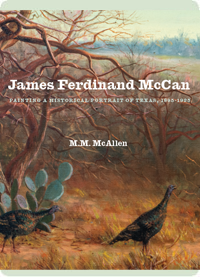 James Ferdinand McCan: Painting A Historical Portrait of Texas, 1895 – 1925 The recent rediscovery of the art
of James Ferdinand McCan tells
the story of the people, landscape,
wildlife, and livestock of Texas at
beginning of the 20th century.
McCan, an Irish immigrant, was
popular with art enthusiasts in a
rapidly changing Texas but to date,
his works remain in private homes.
While his works were shown in the
Witte Museum’s inaugural exhibition
in 1926, this catalog captures
McCan’s first major solo exhibition.
This book reveals his observations as
he illustrated the beauty of his
adopted region just as Texas art began
to surge in popularity. McCan saw
Texas as though he was making a
great discovery about the unique
beauty of the terrain, people, and
creatures great and small. [More...]
James Ferdinand McCan: Painting A Historical Portrait of Texas, 1895 – 1925 The recent rediscovery of the art
of James Ferdinand McCan tells
the story of the people, landscape,
wildlife, and livestock of Texas at
beginning of the 20th century.
McCan, an Irish immigrant, was
popular with art enthusiasts in a
rapidly changing Texas but to date,
his works remain in private homes.
While his works were shown in the
Witte Museum’s inaugural exhibition
in 1926, this catalog captures
McCan’s first major solo exhibition.
This book reveals his observations as
he illustrated the beauty of his
adopted region just as Texas art began
to surge in popularity. McCan saw
Texas as though he was making a
great discovery about the unique
beauty of the terrain, people, and
creatures great and small. [More...]
 See M. M. McAllen’s essay on life lived along the Rio Grande during the Civil War. Long known as a place of cross-border intrigue, the Rio Grande’s unique role in the history of the American Civil War has been largely forgotten or overlooked. Few know of the dramatic events that took place here or the complex history of ethnic tensions and international intrigue and the clash of colorful characters that marked the unfolding and aftermath of the Civil War in the Lone Star State.
To understand the American Civil War in Texas also requires an understanding of the history of Mexico. The Civil War on the Rio Grande focuses on the region’s forced annexation from Mexico in 1848 through the Civil War and Reconstruction. In a very real sense, the Lower Rio Grande Valley was a microcosm not only of the United States but also of increasing globalization as revealed by the intersections of races, cultures, economic forces, historical dynamics, and individual destinies. [More...]
See M. M. McAllen’s essay on life lived along the Rio Grande during the Civil War. Long known as a place of cross-border intrigue, the Rio Grande’s unique role in the history of the American Civil War has been largely forgotten or overlooked. Few know of the dramatic events that took place here or the complex history of ethnic tensions and international intrigue and the clash of colorful characters that marked the unfolding and aftermath of the Civil War in the Lone Star State.
To understand the American Civil War in Texas also requires an understanding of the history of Mexico. The Civil War on the Rio Grande focuses on the region’s forced annexation from Mexico in 1848 through the Civil War and Reconstruction. In a very real sense, the Lower Rio Grande Valley was a microcosm not only of the United States but also of increasing globalization as revealed by the intersections of races, cultures, economic forces, historical dynamics, and individual destinies. [More...]
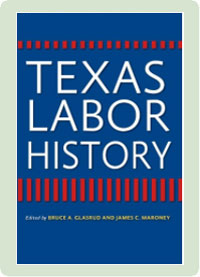 “Better to Die on Our Feet Than to Live on Our Knees: United Farm Workers and Strikes in the Lower Rio Grande Valley, 1966 - 1967,” in Texas Labor History, by Bruce Glasrud and James Maroney. [More...]
“Better to Die on Our Feet Than to Live on Our Knees: United Farm Workers and Strikes in the Lower Rio Grande Valley, 1966 - 1967,” in Texas Labor History, by Bruce Glasrud and James Maroney. [More...]
Soon to be a major motion picture series.
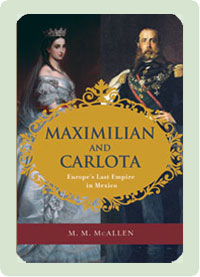 In this new telling of Mexico’s Second Empire and Louis Napoléon’s installation of Maximilian von Habsburg and his wife, Carlota of Belgium, as the emperor and empress of Mexico, Maximilian and Carlota brings the dramatic and tragic story of this six-year-siege to life. From 1861 to 1866, the French incorporated the armies of Austria, Belgium—including forces from Crimea to Egypt—to subdue the regime of Mexico’s Benito Juárez during the time of the U.S. Civil War. France viewed this as a chance to seize Mexican territory in a moment they were convinced the Confederacy would prevail and take over Mexico. With both sides distracted in the United States, this was their opportunity to gain territory in North America. In 1867, with aid from the United States, this movement came to a disastrous end both for the royals and for France—while ushering in a new era for Mexico. [More...]
In this new telling of Mexico’s Second Empire and Louis Napoléon’s installation of Maximilian von Habsburg and his wife, Carlota of Belgium, as the emperor and empress of Mexico, Maximilian and Carlota brings the dramatic and tragic story of this six-year-siege to life. From 1861 to 1866, the French incorporated the armies of Austria, Belgium—including forces from Crimea to Egypt—to subdue the regime of Mexico’s Benito Juárez during the time of the U.S. Civil War. France viewed this as a chance to seize Mexican territory in a moment they were convinced the Confederacy would prevail and take over Mexico. With both sides distracted in the United States, this was their opportunity to gain territory in North America. In 1867, with aid from the United States, this movement came to a disastrous end both for the royals and for France—while ushering in a new era for Mexico. [More...]
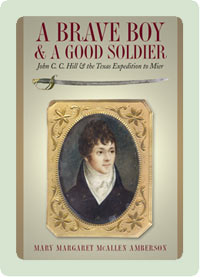 This account of 13-year-old John C. C. Hill demonstrates how this boy adapted in the worst of circumstances to make the most of his situation as a captive in Mexico, and rise to become one of the greatest progressive leaders of the country. John, who went on a punitive expedition to Mexico in 1842, suffered defeat against the Mexican army at Mier on the lower Rio Grande across from Roma, Texas. Later, as a prisoner, his father is made to draw a black or white bean at Salado to determine his fate, in one of the most infamous incidents in Texas history. The boy is ushered to Mexico City, where he rises to near celebrity status, and is made the offer to become the foster son of son of President Antonio Lopez Santa Anna, and his wife. He bargained for the release of his father and brother, and he remained in Mexico. This account also explains the difficult time between the Mexican War and the tentative and final reasoning to claim Texas as a state in the Union. [More...]
This account of 13-year-old John C. C. Hill demonstrates how this boy adapted in the worst of circumstances to make the most of his situation as a captive in Mexico, and rise to become one of the greatest progressive leaders of the country. John, who went on a punitive expedition to Mexico in 1842, suffered defeat against the Mexican army at Mier on the lower Rio Grande across from Roma, Texas. Later, as a prisoner, his father is made to draw a black or white bean at Salado to determine his fate, in one of the most infamous incidents in Texas history. The boy is ushered to Mexico City, where he rises to near celebrity status, and is made the offer to become the foster son of son of President Antonio Lopez Santa Anna, and his wife. He bargained for the release of his father and brother, and he remained in Mexico. This account also explains the difficult time between the Mexican War and the tentative and final reasoning to claim Texas as a state in the Union. [More...]
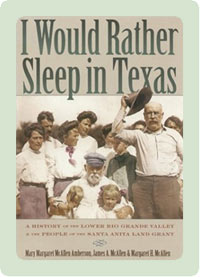 This superb work of history tells the compelling story of the Lower Rio Grande Valley and the people who struggled to make this land their home. Spanish Conquistadors and Mexican revolutionaries, cowboys and ranchers, Texas Rangers and Civil War generals, entrepreneurs and empire-builders are all a part of this thoroughly researched, centuries-long saga.
This superb work of history tells the compelling story of the Lower Rio Grande Valley and the people who struggled to make this land their home. Spanish Conquistadors and Mexican revolutionaries, cowboys and ranchers, Texas Rangers and Civil War generals, entrepreneurs and empire-builders are all a part of this thoroughly researched, centuries-long saga.
Steamboats used the inland waterway as a major transport route and fortunes were made while serving as the Confederacy's only outlet for money and munitions. It is the land from where cattle were driven to the Chisholm Trail and where men, women, and beasts braved the unrelenting climate. It was and remains a crossroads of international culture.
First-hand accounts and the life experiences of the family members of the Santa Anita further enrich this narrative, as do its many rare illustrations. I Would Rather Sleep in Texas tells a remarkable story that covers the broad sweep of Texas and borderlands history.
Mary Margaret McAllen Amberson, a graduate of the University of Texas at Austin and student of history and anthropology, worked with her father, James A. McAllen, who compiled extensive notes, research, and data on South Texas and Valley history. His mother, Margaret H. McAllen, a former member of the TSHA and the Texas Historical Commissions, began the book project in 1978. [More...]
